
Subscribe to Pittwire Today
Get the most interesting and important stories from the University of Pittsburgh.Stake out in Pennsylvania’s Cook State Forest at the right time of year and you can see one of nature’s great light shows: swarms of fireflies that synchronize their flashes like strings of Christmas lights in the dark.
A new study by Pitt mathematicians shows that math borrowed from neuroscience can describe how swarms of these unique insects coordinate their light show, capturing key details about how they behave in the wild.
“This firefly has a quick sequence of flashes, and then a big pause before the next burst,” said Jonathan Rubin, professor and chair of the Department of Mathematics in the Kenneth P. Dietrich School of Arts and Sciences. “We knew a good framework for modeling this that could capture a lot of the features, and we were curious how far we could push it.”
Male fireflies produce a glow from their abdomens to call out to potential mates, sending out blinking patterns in the dark to woo females of their own species. Synchronous fireflies of the species Photinus carolinus take it a step further, coordinating their blinking throughout entire swarms. It’s a rare trait — there are only a handful of such species in North America — and the striking lights they produce draw crowds to locations where the insects are known to gather.
They’ve also attracted the interest of mathematicians seeking to understand how they synchronize their blinks. It’s just one example of how synchronization can evolve from randomness, a process that has intrigued mathematicians for centuries. One famous example from the 1600s showed that pendulum clocks hung next to one another synchronize through vibrations that travel through the wall, and the same branch of math can be used to describe everything from the action of intestines to audience members clapping.
“Synchrony is important for a lot of things, good and bad,” said co-author Bard Ermentrout, distinguished professor of mathematics in the Dietrich School. “Physicists, mathematicians, we’re all interested in synchronization.”
To crack the fireflies’ light show, the Pitt team used a more complex model called an “elliptic burster” that’s used to describe the behavior of brain cells. The duo, along with then-undergrad Madeline McCrea (A&S ’22) published details of their model Oct. 26 in the Journal of the Royal Society Interface.
The first step was to simulate the blinks of a single firefly, then expand to a pair to see how they matched their flashing rates to one another. Next, the team moved to a bigger swarm of simulated insects to see how number, distance and flying speed affect the resulting blinks.
Varying the distances each firefly could “see” each other and respond to one another changed the insects’ light show, they found: By tweaking the parameters, they could produce patterns of blinks that looked like either ripples or spirals.
The results line up with several recently published observations about real-life synchronous fireflies — for instance, that individual fireflies are inconsistent while groups flash more regularly, and that when new fireflies join the swarm, they’re already perfectly in time.
“It captured a lot of the finer details that they saw in the biology, which was cool,” said Ermentrout. “We didn't expect that.”
The math also makes some predictions that could inform firefly research — for instance, light pollution and the time of day both may alter the patterns produced by fireflies by changing how well they can see one another’s blinks.
McCrea worked on the research as an undergraduate supported by the department’s Painter Fellowship, which gave her funding to work on the project through the summer. “She was awesome working on this project, and really persistent,” said Rubin.
The team is the first to use this particular brain-cell framework to model fireflies, which several different research teams are trying to understand using different types of math. “It’s more of a wild west research topic,” said Ermentrout. “It’s early days, and who knows where things are going to go from here?”
Ermentrout and Rubin also hopeful that the math will capture the imagination of those inspired by the glow of fireflies. In the midst of this project, Rubin himself decided to head up to Cook State Forest in Clarion County to see if he could spot his research subjects firsthand.
“I convinced my wife to go on a trip for a couple of days right in the peak of the season,” he said. “It’s not clear we ever saw synchronized activity, but there were all sorts of fireflies around us. It was amazing.”
— Patrick Monahan, photo via Getty


